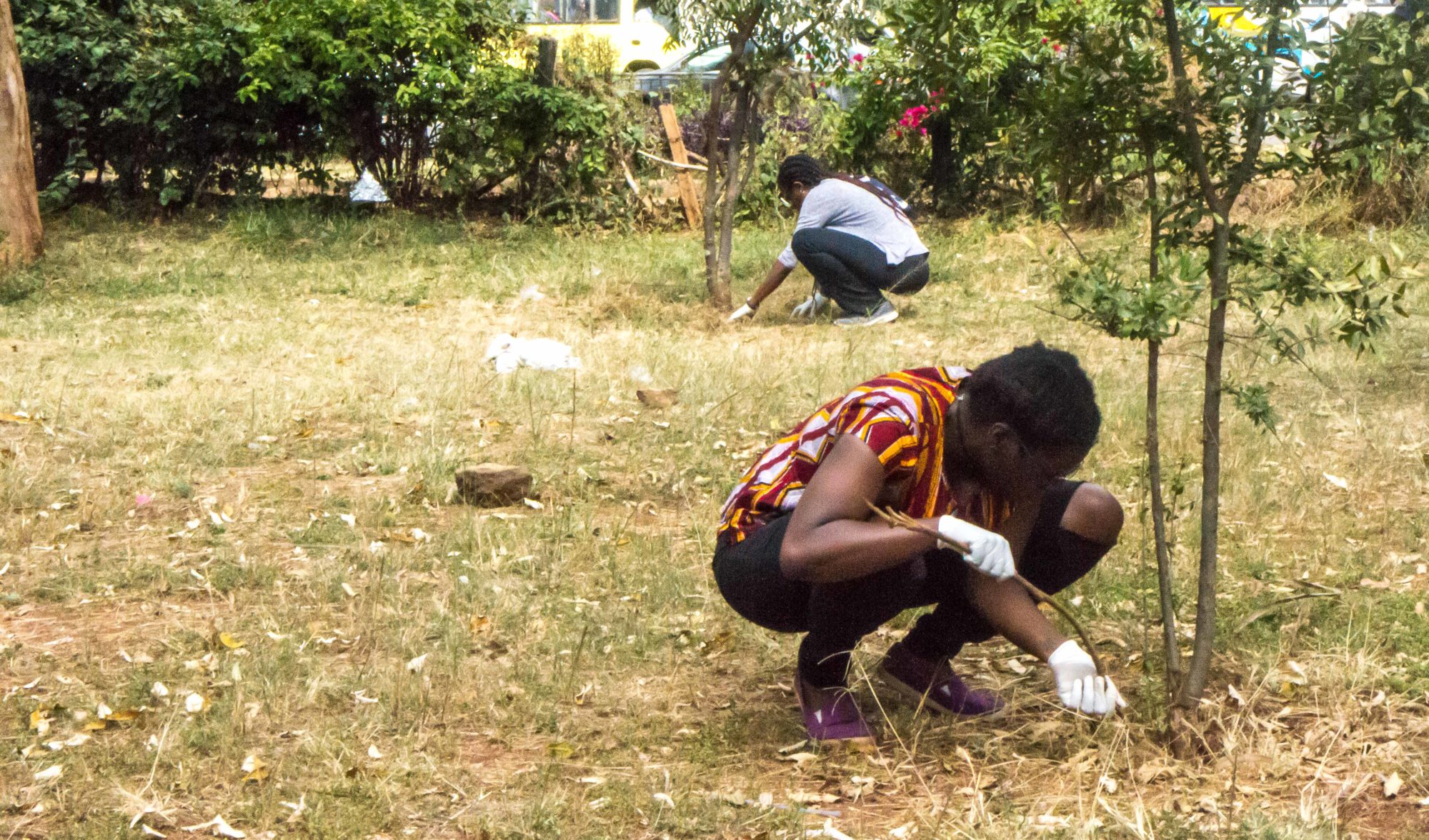I’m not who you think I’m not #4: Chebomuren
Share:
I’m Not Who You Think I’m Not #4: Chebomuren was a two hour performance by artists Awuor Onyango, Nyakallo Maleke, and Sanyu Kiyimba-Kisaka that took place February 15, 2018, at Freedom Corner in Uhuru Park, Nairobi. Part of an ongoing project called the School of Anxiety (SoA)—“an (un-)learning environment focused on subjective anxieties” initiated by curator and critic Moses Serubiri within the framework of the 10th Berlin Biennale for Contemporary Art (June 9 – September 9, 2018)—the work addresses “the anxieties of mourning and ethnic subjectivity that have colored recent memory in Kenya.” It is possible to speak of “recent memory” as living somewhere between the experience of the everyday, the past, the present-past, and the present, where there might be discrepancies between memories and the bodies and objects that contain and reflect them. What or who determines what is made visible and what is silenced in our collective memory?
Part of a series of I’m not who you think I’m not interventions initiated by Serubiri that has so far taken place in Johannesburg and Berlin as well as Nairobi, I’m not who you think I’m not #4: Chebomuren was the result of an internal workshop focused upon those silenced collective anxieties and their subjectivities. The public presentation of the participants’ collective study was a performance at Freedom Corner, which began with the three women cleaning and weeding under the trees in silence, moving from the base of one tree to another. When they finished weeding, one took a ball of acrylic yarn from beneath a eucalyptus tree and threw it to the others; each in turn tied it to the tree beside her before moving on to the next to repeat the action in a triangulation. As the performers—whose individual artistic practices range from sound and video work to playwriting and choreography—continued they introduced more yarn, of different colors. Carrying the balls in different directions away from each other, they began to accelerate, exchanging words, sounds, laughs, and things among themselves as if playing a form of “tag.” In a short time they had created a maze of intertwined thread strung across the trees, and when they ran out of yarn, the performers came to the center of their labyrinth and began to braid the yarn, making contact and connections.
What connections—between the trees, between past and present, or between agitation and inner experience—might be made here are in part bound up with the history and environment at Freedom Corner. Uhuru Park is the site of a number of national monuments and a gathering spot in Nairobi, often for political and ideological assembly. In recent decades it has been a place of protest against governmental action, and some of those protests have been violently oppressed. So it is also a place of commemoration, not only of colonial-period hardship and subsequent times but also for lives lost in protests and political rallies within the park itself. The specific memory invoked by Onyango, Maleke, and Kiyimba-Kisaka is that of the historic protest of February 1992, when a group of older women congregated in Uhuru Park as part of a hunger strike against President Daniel arap Moi, who had detained a group of young opposition politicians. To commemorate the 16 women who began the protest, the National Council of Women in Kenya planted 16 trees in Freedom Corner, where a sign now reads: “Lest We Forget!” In Chebomuren, the performers acknowledge these trees as agents, as significant bodies of memory. The work also engages trees’ spiritual role, foregrounding the importance of trees in Kenyan mythology and folklore, wherein they are seen as “homes of gods,” such as the Mugumo, Mukuyu, and Seno. The artists’ acknowledgement and treatment of these trees in the performance reveal acts of care as one way to address certain anxieties surrounding history, place, and erasure—for instance, the erasure of the spiritual symbols and the women agents who have been largely been suppressed in Kenya’s recent political and social history.
Serubiri, who is one of five members of the 2018 Berlin Biennale’s curatorial team, has noted that anxiety is often defined from the “white male” perspective, and that much of what is investigated in I’m not who you think I’m not pushes back against this definition. Many of the conversations in the build-up to the performance were about deconstructing what we mean when we say “anxiety,” be it in reference to personal anxiety or to social anxieties that are shared in common, particularly with regard to the process of education in our neighborhoods, homes, and communities. Central to that interrogation is the fundamental question, “How do we become who we are?” Serubiri also described the performance as a gesture in thinking alongside the silences of and for the erased, in such a way that would not lead to the creation of a “spectacle” but, instead, to respect for and even an experience of this silence, such that viewers might further enact or reflect it within their own gestures.
For the performance finale, the artists removed the yarn, packed it in bags, took pictures around the “Lest we forget!” sign, and departed. Around Freedom Corner, after the performance, other routines and rituals continued, and they continue still: the Kanjo askaris (city council police) patrol, a constant reminder that a likelihood always exists that you might be arrested there; hawkers sell their goods; and various other forms of exchange are embodied by passersby crossing the park from Central Business District to Upper Hill, occasionally stopping to look at the constant and layered performance of anxiety that takes place in the park, in the street, and in daily life in Nairobi, or as an artist—regardless of whether that anxiety is being performed and commemorated.


